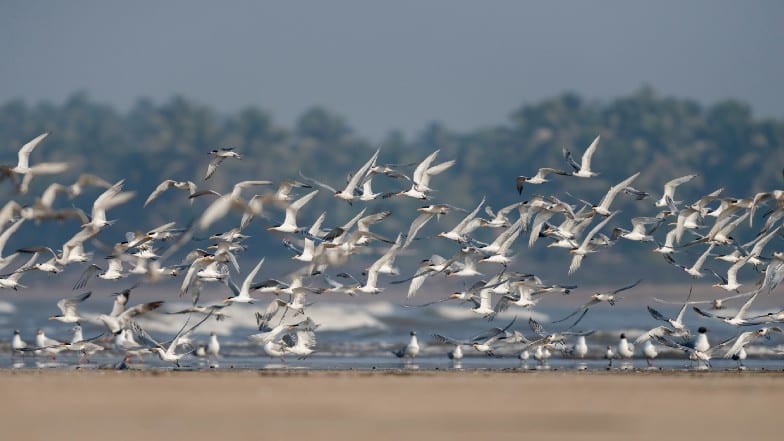On the 14th of October, the UN commemorates World Migratory Bird Day (WMBD). The day was established to raise awareness about the threats facing these fascinating creatures that travel vast distances during their seasonal movements.
To celebrate the day, here are 10 facts on migratory birds.
1. Birds migrate for better conditions
Migration involves long and often dangerous journeys. Migratory birds fly hundreds and thousands of kilometres to find the best ecological conditions and habitats for feeding, breeding and raising their young. When conditions at breeding sites become unfavourable, they fly to regions where conditions are better.
The majority of birds migrate from northern breeding areas to southern wintering grounds. However, some birds breed in southern parts of Africa and migrate to northern wintering grounds, or horizontally, to enjoy the milder coastal climates in winter.
2. World Migratory Bird Day is celebrated twice in one year
The day is marked on the second Saturday of May and October (13 May and 14 October in 2023), to reflect the cyclical nature of bird migration. The arrival and departure dates of migration have been consistent over the years as birds use environmental cues, including temperature, to determine when they should take flight. However, due to global warming, their annual migration rhythm is changing. Many migratory birds have to alter their routes, shorten or completely cancel their journey due to changing temperatures.
3. 2023’s World Migratory Bird Day highlights how essential water is for migratory birds
The Day is this year celebrated under the theme “Water: Sustaining Bird Life”. Migratory birds require water such as lakes, rivers, streams, ponds and coastal wetlands for migration as they provide a place to rest and refuel, and for nesting and breeding.
4. Migration consists of long and demanding journeys
Migration involves long journeys and flight is one of the most demanding form of locomotion, with days of continuous flapping of the birds’ wings without a chance to rest. This requires migratory birds to store large deposits of fat prior to departure. Birds’ heart rates can increase by 400% and their core body temperature has been recorded to be as high as 44.4˚C in flight. This overheating causes birds to stop flying, which in turn can be problematic if the environment is not suitable for landing or if birds run into a predator.

5. Migratory birds travel over land and sea
Many birds follow distinct pathways when migrating, called Flyways. The UK and Ireland are located on the East Atlantic Flyway, which is a migration path for birds stretching from Russia, Greenland and Canada all the way to Southern Africa.
Physical landmarks, such as mountain ranges, river valleys or coastlines, are used by several birds to guide them. Others travel more directly, even if this means crossing dangerous stretches of desert or sea. Some smaller birds cross the Mediterranean Sea wherever possible by continuous flapping, while many larger birds opt for the narrowest points of crossing.
6. Migratory birds can navigate with pin-point accuracy
It has been shown that migrating birds are able to orientate by the sun during the day, by the stars at night, and by the geomagnetic field at any time. Some species can even detect polarised light, which many migrating birds may use for navigation at night.
7. Migratory birds are key players in our ecosystems
They act as agents of pest control, and a source of food for other wildlife and, in turn, they protect crops and pollinate plants.
8. One in eight bird species globally are threatened with extinction
Approximately 2,000 of the 11,000 bird species in the world migrate. In the European Union, 39% of bird species are in poor and bad conservation status. In the United Kingdom, more than a quarter (29%) of birds assessed are under threat.
9. Migratory waterbirds are among the bird species most at risk of extinction
Waterbirds are species ecologically dependent on wetlands for at least part of their annual cycle. But these aquatic ecosystems are under threat around the world. Increasing human demand for water as well as pollution and climate change endanger these precious ecosystems and the migratory birds that depend on them.
More widely, invasive alien species, habitat loss, oil spills, poorly positioned wind turbines and power lines, and plastic pollution are among the threats all migratory birds face.
10. International cooperation is vital for the conservation of migratory birds
Flying long distances involves crossing many borders between countries with differing measures. The legal framework and coordinating instruments necessary for such cooperation is provided by multilateral environmental agreements.
We can also take individual action:
- Do not hunt endangered bird species
- Recycle plastic and never litter
- Pick up trash in freshwater areas
- Refrain from buying meat or products made from the leather or feathers of migratory bird species
See also:
- World Migratory Bird Day 2023
- UN Convention on Migratory Species
- Birds without Borders
- Migratory birds: to the moon and back in a lifetime
- Protection of migratory birds and their habitats for people and the planet
- The Growing Effects of Light Pollution on Migratory Birds
- Convention on the Conservation of Migratory Species of Wild Animals

